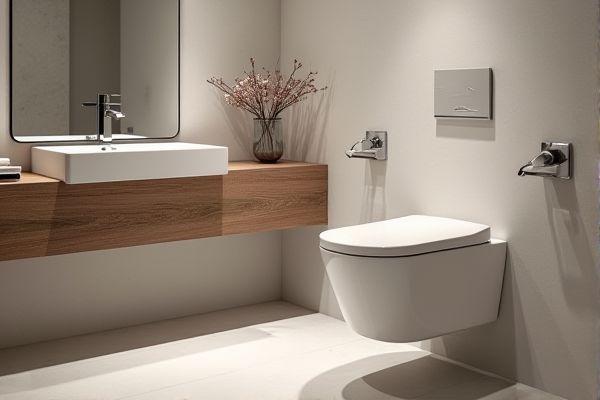
A floating toilet uses a buoyant, water-saving design that minimizes water usage and increases comfort compared to a standard toilet's traditional flush mechanism. Discover how Your choice between these options affects efficiency, maintenance, and bathroom aesthetics by reading the rest of the article.
Table of Comparison
| Feature | Floating Toilet | Standard Toilet |
|---|---|---|
| Installation | Wall-mounted, saves floor space | Floor-mounted, requires more space |
| Design | Modern, sleek appearance | Traditional, bulky design |
| Cleaning | Easy access underneath for cleaning | Harder to clean around base |
| Cost | Higher initial cost and installation | Lower purchase and installation cost |
| Maintenance | Requires wall support inspection | Simple, accessible maintenance |
| Weight Support | Supports up to 500 lbs with proper installation | Supports standard weight limits (~300-400 lbs) |
| Water Efficiency | Often includes dual-flush options | Varies, usually single-flush models |
Introduction to Floating and Standard Toilets
Floating toilets are elevated sanitary fixtures designed to prevent direct contact with contaminated ground or water, often used in flood-prone or waterlogged areas. Standard toilets are fixed installations connected to a sewage system or septic tank, commonly found in most residential and commercial buildings for efficient waste disposal. The key distinction lies in their structural design and suitability for different environmental conditions, impacting installation and maintenance requirements.
Design Differences: Floating vs Standard Toilets
Floating toilets feature a wall-mounted design that elevates the bowl off the floor, creating a sleek, modern look and making cleaning easier by eliminating hard-to-reach areas. Standard toilets are floor-mounted with visible plumbing connections, offering a traditional and robust design that fits most bathroom layouts and budgets. Your choice between floating and standard toilets impacts bathroom aesthetics, maintenance, and space utilization.
Space Utilization and Bathroom Aesthetics
Floating toilets maximize space utilization by mounting directly to the wall, freeing up floor area and creating a more open, airy bathroom environment. Their sleek, minimalist design enhances bathroom aesthetics by offering a modern, streamlined look compared to the bulkier footprint of standard toilets. This design choice not only improves visual appeal but also simplifies cleaning and maintenance underneath the toilet.
Installation Requirements and Considerations
Floating toilets require wall reinforcement and concealed plumbing, demanding precise measurements and professional installation to support the unit's weight securely. Standard toilets need a stable floor surface with a flange anchored to the subfloor, allowing simpler installation and easier access for repairs. Your choice affects installation complexity, costs, and bathroom layout flexibility, making preparation and skill level crucial factors.
Comfort and Ergonomics Comparison
Floating toilets offer enhanced comfort by providing customizable height options that accommodate diverse user needs, promoting better posture and reducing strain. Standard toilets typically have a fixed height that may not suit all users, potentially causing discomfort and ergonomic issues over prolonged use. Ergonomically, floating toilets support improved accessibility and ease of cleaning, contributing to a healthier bathroom environment.
Maintenance and Cleaning Ease
Floating toilets offer easier maintenance and cleaning due to their elevated design, which provides better access underneath and around the unit, reducing dirt and grime buildup. Standard toilets with floor-mounted bases often trap dust and moisture at the seal, requiring more frequent and detailed scrubbing. Choosing a floating toilet can simplify your bathroom upkeep, saving time and effort while maintaining hygiene.
Durability and Lifespan Analysis
Floating toilets, designed with innovative materials like high-density polyethylene and corrosion-resistant metals, offer enhanced durability compared to standard porcelain toilets, which are prone to cracking and chipping over time. The lifespan of floating toilets often exceeds 15-20 years due to their resistance to rust, mold, and impact damage, while standard toilets typically last around 10-15 years with proper maintenance. Your choice impacts long-term investment, as floating toilets reduce repair frequency and replacement costs through superior material resilience and structural integrity.
Cost Comparison: Initial and Long-Term Expenses
Floating toilets typically have a higher initial cost compared to standard toilets due to advanced design and installation requirements. Over time, maintenance expenses for floating toilets may be lower because of their efficient water usage and durable materials, potentially saving you money on repairs and water bills. Standard toilets often incur higher long-term costs due to increased water consumption and more frequent repairs, affecting overall household expenses.
Water Efficiency and Eco-Friendliness
Floating toilets significantly reduce water usage by incorporating advanced flushing mechanisms that use as little as 0.8 gallons per flush, compared to standard toilets which typically use 1.6 gallons or more. The design of floating toilets often includes features such as dual-flush systems and efficient bowl shapes, enhancing water conservation and reducing environmental impact. This eco-friendly approach helps decrease water waste and supports sustainable living practices, making floating toilets a superior choice for water efficiency compared to conventional models.
Choosing the Right Toilet: Key Factors to Consider
Selecting the right toilet involves evaluating installation type, water efficiency, and space constraints. Floating toilets, installed off the floor, offer easier cleaning and modern aesthetics, ideal for compact or minimalist bathrooms, while standard toilets provide robust installation and often lower upfront costs. Water consumption rates and flushing technology impact long-term savings and environmental footprint, making these critical factors in the decision-making process.
 homyna.com
homyna.com